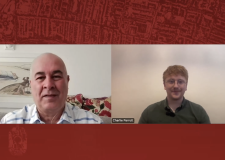Improvement plans for Brighton hospital
Brighton hospital bosses agree action plan as annual report flags up key challenges as well as achievements. Frank le Duc reports

More than 775,000 patients came through the doors of the hospitals and treatment centres run by the Brighton and Sussex University Hospitals NHS Trust in the past year. The Royal Sussex County Hospital in Kemp Town is the biggest and busiest. The others include the Royal Alexandra Children’s Hospital and the Sussex Eye Hospital in Brighton as well as the Princess Royal Hospital in Haywards Heath.
Many of those patients received the right treatment in the right place at the right time. But the growing pressure on accident and emergency (A&E) departments across the country was reflected in the difficulties encountered at the Royal Sussex over the past winter. The official watchdog, the Care Quality Commission (CQC), sent inspectors to see the situation for themselves.
Unsurprisingly, the focus has been on the CQC’s criticisms and how to put right the problems that the independent watchdog identified. That focus was evident when the hospital trust board met last week. It included a report on the action plan being followed as doctors, nurses and support staff look to raise standards and improve patient care.
The issues included treating patients with privacy and dignity and making sure they were admitted to wards more promptly. Some patients were left unable to wash properly and had inadequate toilets. Others were left held in the A&E corridors. The way that some older frail patients were treated compromised their mobility and independence.
The CQC said that some patients, staff and visitors were not being protected against the risk of unsafe or unsuitable premises. It said that clinical waste was not being managed or stored securely in line with the rules and regulations. Hospital trust staff are working with their colleagues at the South East Coast Ambulance Service to ensure greater clarity about the roles and responsibilities of everyone in A&E. And talks are being held with the Brighton and Hove Clinical Commissioning Group (CCG) about community placements for rehabilitation, intermediate care and respite care. The Sussex Community Trust – another NHS provider – is also involved in tackling this.
The CQC does not just send in inspectors, identify shortcomings and then walk away. It expects NHS trusts to draw up plans to put things right and to monitor whether those plans are working. They have to gather evidence and share and discuss it with the CQC to satisfy the watchdog that positive changes are taking place.
PRESSURE
The trust board also reviewed its annual report last week. In the report the trust chief executive Matthew Kershaw said: “I joined as chief executive of Brighton and Sussex University Hospitals at the beginning of April at a time when we were experiencing some very real and acute challenges, particularly in relation to the experience of patients admitted to the hospital in an emergency. We were not alone in this as the winter of 2012-13 put many other hospitals locally and across England under similar pressure.”
And trust chairman Julian Lee said: “It is impossible to talk about 2012-13 without referencing the inquiry into the significant failings in the care of vulnerable patients at Mid Staffordshire NHS Foundation Trust. The publication of the Francis Report has changed the landscape in which the NHS operates. In response, along with every hospital in England, we are taking a long hard look at our priorities and ensuring we have in place the necessary checks and governance arrangements to assure ourselves and others that we understand what is happening in our hospital.
“Members of the public are always welcome to attend our monthly board meetings, the dates and venues for which are published in advance on our website and we would encourage anyone with an active interest in the hospital to come along.
“As a board we have a responsibility to ensure that in the light of the ever-increasing demands, and competing priorities facing every NHS organisation, we never lose sight of our primary responsibility: to provide efficient, effective and compassionate patient-centred care. Hearing the views and experiences of those who have actually used our services is an essential factor in our ability to do this well.”
“Our primary responsibility – to provide efficient, effective and compassionate patient-centred care”
The report praises the hard work and determination of many of the trust’s unsung heroes, including an astonishing number of volunteers. It said: “We have 516 local people who volunteer their time to help (the trust) maintain quality care for patients. Collectively devoting many hundreds of hours a week, the volunteers work in a variety of roles, such as assisting on wards, in outpatient clinics, and receptions.
“There are a number of charitable organisations, including the League of Friends and WRVS, whose volunteers fundraise through on-site shops and other ventures, as well as gift donations to help purchase much-needed equipment for the hospital.
VALUABLE
“BSUH has numerous fundraising charities and groups that work tirelessly to raise money to help us enhance our services, improve our buildings and facilities and make coming into hospital a more comfortable and less anxious experience.
“The Sussex Cancer Fund has been giving invaluable assistance to the Sussex Cancer Centre at the Royal Sussex County Hospital for many years, providing additional equipment and building improvements for the treatment of cancer patients.
“Rockinghorse is the official fundraising arm of the Royal Alexandra Children’s Hospital and the Trevor Mann Baby Unit at the Royal Sussex County Hospital. They raise money for life-saving equipment
and help to ensure children are treated in an environment that best suits their needs.”
The report gives an update on the major revamp – known as the 3Ts project – planned for the Royal Sussex site. It said: “The first of the 3Ts related building projects, renovating St Mary’s Hall, began in December 2012. St Mary’s will be the permanent home for administration and management services and will also supply accommodation for some junior doctors and rotational staff.”
The trust was given approval to build a third cardiac theatre at the Royal Sussex. The new theatre will provide innovative treatment and increase surgical capacity to reduce the number of patients needing to go to London for treatment. And the report records the £400,000 grant received from the Department of Health’s £25 million capital funding programme to improve maternity and labour wards in Brighton and Haywards Heath.
The report also discusses the trust’s carbon footprint. It said: “At the end of 2011-12 we had reached 10 per cent of our overall target of 25 per cent reduction in direct carbon emissions by 2014-15 from a base date of 2008-09. The forecast out-turn for 2012-13 shows a reverse of this trend and put us back to 2008-09 levels. The reason for the upturn in carbon emissions is due to lower temperatures than that of the last two years and increased business activity. To date 27 energy-saving projects have been completed and seven more are currently in progress.”




















